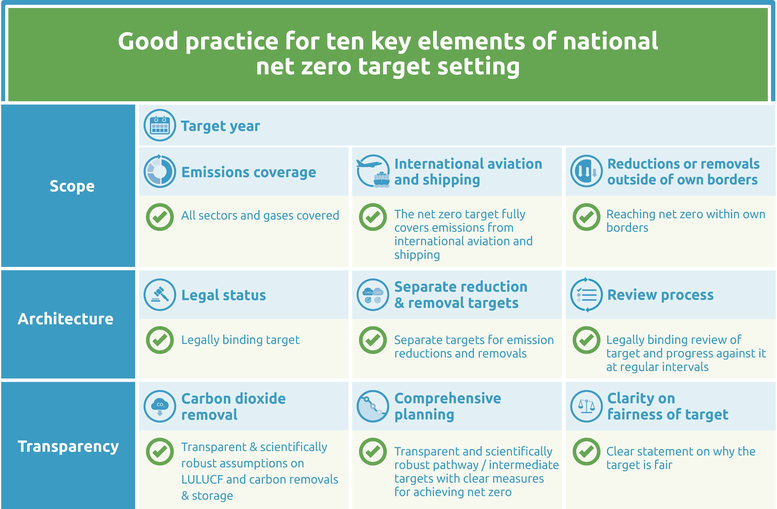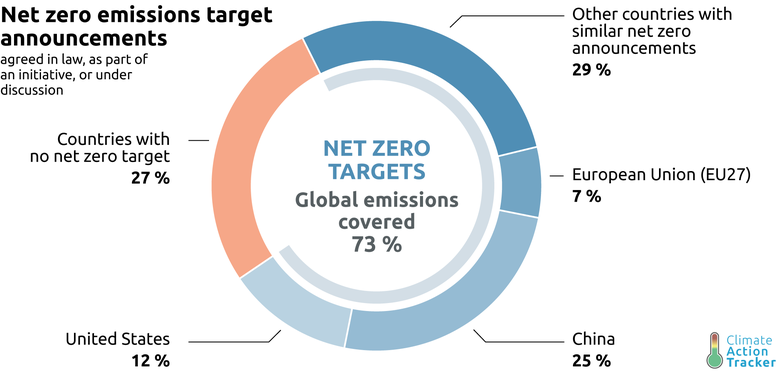What makes a good national net zero target? Our ten-step evaluation methodology, explained
by Frederic Hans, Silke Mooldijk & Claire Fyson
The urgent need for nuanced and transparent assessments of national net zero targets
The last year has seen a wave of national net zero target announcements. This has triggered an important discussion among policy makers, civil society, and academics on the usefulness, scientific robustness, and real-world impact of these targets.[i]
At their best, well-designed and ambitious net zero targets are key for reducing global carbon dioxide and other greenhouse gas emissions to net zero around 2050 and 2070, respectively. This is necessary to keep to the Paris Agreement’s 1.5°C temperature limit. Ambitious net zero targets can also guide the implementation of Paris-aligned actions in the short and medium term, in particular 2030 emission reduction goals.
At their worst, net zero targets are unclear or not backed up by real-world action. Net zero targets can distract from the urgent need for deep emissions reductions if 2030 targets and short-term action are inconsistent with their achievement, allowing governments to “hide” behind aspirational net zero targets. Unless governments start acting now, their chances of achieving net zero will be slim.
Recent analysis by the Climate Action Tracker (CAT) in April 2021 showed that if fully implemented, governments’ net zero targets can make a substantial dent in future warming levels, but also warned that steep near-term mitigation efforts are needed to make that feasible. As of May 2021, a total of 131 countries had adopted or announced net zero targets. These countries cover about 73% of global emissions and include key emitters like the United States of America, China, and the European Union (see Figure 1).
Our assessment found that global warming by 2100 could be as low as 2.0°C if all the net zero targets announced or under consideration (but not yet submitted to the UNFCCC) were to be achieved – still far from 1.5°C but representing substantial progress. This stands in stark contrast to the expected global warming levels under submitted Paris Agreement targets and pledges (2.4°C) and currently implemented policies (2.9°C).
There are many uncertainties in estimating the impact of net zero targets, not least because underlying assumptions may not be clear, the targets may not be comprehensive, or their legal status and likelihood of being fully implemented are uncertain.
There is a clear need for a nuanced assessment of incoming national net zero targets to understand their scope, architecture, and transparency. Without such scrutiny, there is a risk that poorly backed up net zero claims could render these targets meaningless.
Figure 1: Share of GHG emissions covered by countries that have adopted or announced net zero emission targets (agreed in law, as part of an initiative, or under discussion). Compilation based on ECIU (2021) as of 29 April 2021 complemented by CAT analysis. Emissions data for 2017 taken from EDGAR emissions database (EDGAR, 2019).
The CAT has developed a method for evaluating countries’ net zero targets, guided by three key objectives:
- Create transparency about governments’ long-term commitments;
- Assess the robustness and comprehensiveness of net zero targets announced;
- Foster mutual learning and disseminate good practice.
Our evaluation method remains exclusively applicable to net zero targets by national governments and cannot be directly applied to other subnational or non-state actors (especially corporations).
Our CAT’s ten-step net zero target evaluation methodology explained
The CAT has identified ten key elements of each country’s net zero target to assess whether the scope, architecture, and transparency meet what we define as good practice (see Figure 2).

Figure 2: Identified good practice for all ten key elements in the Climate Action Tracker’s evaluation methodology for countries’ net zero targets.
Our ten-step analysis of net zero targets can be divided into three separate sections:
Scope
1.Target year: governments should communicate their target year, or short period (e.g., a five-year interval), for achieving net zero. The CAT has not yet assessed the adequacy of individual countries’ net zero target years due to remaining challenges around assessing whether they are aligned with the Paris Agreement 1.5°C temperature limit, given specific national circumstances and data gaps that are in the process of being filled. Nevertheless, carbon dioxide needs to reach net zero globally by around 2050, and all greenhouse gas emissions net zero around 2070. Governments’ targets need to be fully consistent with the achievement of these global outcomes.
2. Emissions coverage: the most transparent and comprehensive net zero targets cover all GHGs, all sources, and all economic sectors.
3. International aviation and shipping: net zero targets should cover emissions from international aviation and international shipping. We assess the coverage of international bunkers separately to highlight their importance for net zero targets; and to better distinguish between governments that include international bunkers in their net zero target and those that do not.
4. Reductions or removals outside of own borders: the most transparent and comprehensive net zero targets explicitly state that the country will reach net zero emissions within its own borders where this is feasible. Countries that delay their domestic emissions reductions and hence rely on reductions or removals outside of their own borders to achieve their net zero target may hinder the achievement of net zero global emissions and the Paris Agreement’s temperature limit of 1.5˚C.
Architecture
5. Legal status: net zero targets should be enshrined in national law to guarantee that countries will work towards achieving their target. Implementation risks and uncertainty on legal bindingness remain if governments only include net zero targets in proposed policy documents such as Nationally Determined Contributions (NDCs) or Long-Term Strategies (LTS), or in announcements by Heads of Government.
6. Separate reduction & removal targets: the most comprehensive and ambitious net zero targets include separate sub-targets for emission reductions and removals. Such differentiation allows for transparent progress tracking of both (rapid) emission reductions and removals (or negative GHG emissions)
7. Review process: a legally binding review that meets good practice includes the review and revision of the target itself at regular intervals, and regularly tracks the achieved progress against the target. Governments might choose slightly different approaches on how to structure and time their review processes.
Transparency
8. Carbon dioxide and GHG removals: transparent assumptions on the role of the land use, land-use change, and forestry (LULUCF) sector and other technical carbon dioxide removal (CDR) options provide clarity on how a country wants to achieve net zero. Removals cannot replace deep emission reductions, and should rather be used to balance emissions that cannot be rapidly abated and to realise net negative emissions after achieving net zero. Particular caution should be taken over the use of forest and other ecosystem-based removals because of their high uncertainties and risk of carbon re-release as a result of increasingly adverse climatic conditions in many regions, such as drought, more frequent wildfires, high temperatures and other extreme events.
9. Comprehensive planning: a comprehensive planning process and the execution of actionable short and medium-term measures to reach net zero increases the chances that a net zero target will be successfully implemented. This provides a net zero target with credibility and helps to ensure timely realisation of deep decarbonisation.
10. Clarity on fairness of target: net zero targets should be accompanied by an explanation of why that target is a ‘fair’ contribution to the global goal of limiting warming to 1.5˚C above pre-industrial levels considering different normative assumptions. Developed countries in particular should explain how they will make up for any difference between what would be a fair contribution and what would be a realistic contribution, for example by supporting other countries in decarbonising their economies without claiming credits for use towards their own targets.
We use these ten elements for those targets with enough information available to give them an overall assessment of ‘acceptable’, ‘average’, or ‘poor’. Some targets have not yet been described in any detail, and fall into the ‘target information incomplete’ category. Our published full methodology explains the assessment for each element (Section 3) and the headline evaluation categories (Section 4) in greater detail.
Outlook going forward: Upcoming assessments for 40 countries worldwide
From August 2021, the CAT will begin evaluating net zero targets for all 40 countries that are regularly covered in our country assessments, covering more than 81% of today’s global emissions. At the time of writing, 24 out of those 40 countries have adopted or announced net zero targets providing different levels of information. We intend to gradually complete all assessments towards COP26 by November 2021 and will continue to provide updates as governments announce, update, or concretise their net zero target commitments.
[i] Since the beginning of 2021, for example, there have been several recent academic publications such as Smith (2021), Rogelj et al. (2021) or van Soest (2021) and blogposts such as Dyke et al. (2021), Dubash et al. (2021) or Black et al. (2021) that have given a range of views on net zero targets, highlighting potential benefits and risks, and scrutinizing different aspects.
Stay informed
Subscribe to our newsletter
